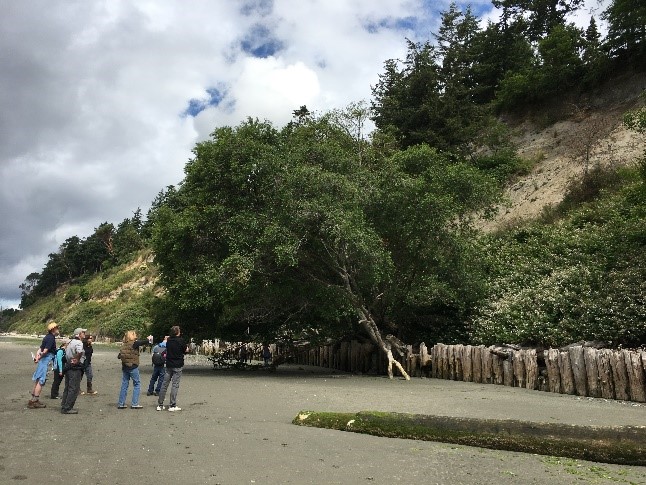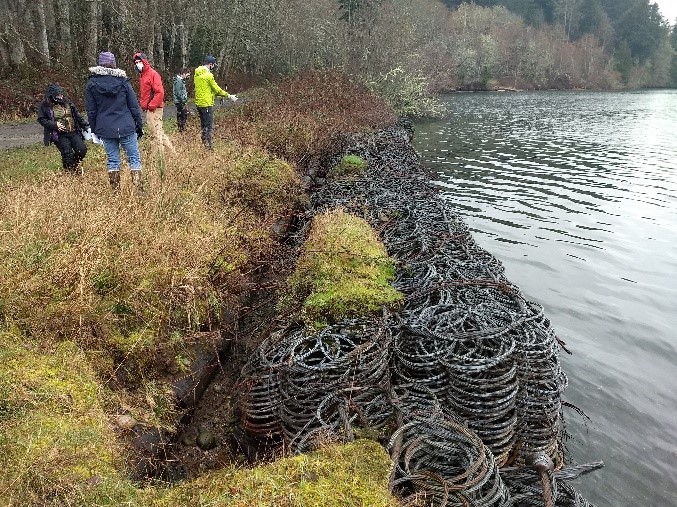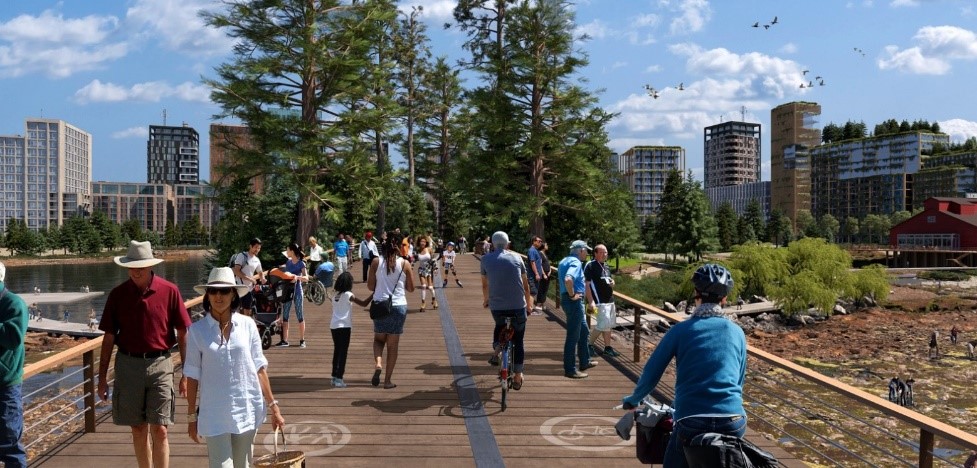In late December 2022, coastal communities across the Salish Sea experienced devastating flooding from exceptionally high tides, referred to as king tides. These tides coincided with a storm surge, resulting in record-breaking high-water levels throughout Puget Sound and beyond. The influx of water to low-lying areas damaged infrastructure and homes, disrupting daily life across the region. High tide flooding provides a glimpse into future conditions in the Northwest.
As sea levels continue to rise, water levels will reach higher and extend further inland, causing more frequent, widespread flooding and coastal erosion. As a result, some areas will become permanently inundated, leaving significant changes to Puget Sound beaches and bluffs. While a future with rising waters remains an immense challenge, it is also an opportunity to adapt in ways that achieve multiple benefits. Coastal nature-based solutions are one such example. Nature-based solutions are natural or engineered systems that mimic natural processes, and are designed to reduce flooding, erosion, and runoff. Along the coast, nature-based solutions, such as living shorelines, support wildlife habitat, water quality, and recreation. At Herrera, our multidisciplinary team of scientists and engineers are at the forefront of helping coastal communities be more resilient to rising waters through proactive planning and innovative coastal adaptation approaches that integrate nature-based solutions.
Protecting Waterfront Properties through Nature-Based Solutions

Amidst Washington State’s vast 2,500 miles of shoreline are over 55,000 parcels of state, residential, and commercial property. As rising seas continue to increase flooding and erosion hazards for shoreline property owners, learning how to adapt remains difficult. The Shore Friendly program of the Northwest Straits Foundation (NWSF) helps these residents by providing outreach, technical assistance, and education for shoreline property owners, improving stewardship of private shorelines while maintaining coastal ecosystem processes. For over a decade, Herrera coastal geomorphologist, Andrea MacLennan, has provided technical assistance to the region’s Shore Friendly programs, conducting free virtual and in-person educational workshops and site assessments for shoreline landowners in Whatcom, Skagit, Island, Jefferson, Snohomish, San Juan, and Clallam Counties. Site reviews include interpreting geologic conditions, reviewing geomorphic data, and collaborating on recommendations for property owners that will build resilience and nearshore ecosystem health. When determining actions for protecting waterfront properties, the Shore Friendly program embraces the conservation of natural processes and implementation of ‘soft’ methods and nature-based solutions, using natural materials that accommodate water, reduce erosion, and mimic natural shoreline characteristics. Taking a nature-based, restorative approach in place of ‘hard’ methods, such as building shoreline armoring and bulkheads, lessens the impact on beaches and habitats while providing effective protection for years to come. Our team has decades of experience with soft shore protection and armor removal projects across Puget Sound to assist shoreline property owners with the creation and implementation of ‘living shorelines’ that will help keep properties and communities resilient in the face of future conditions.
Naturalizing Beaches for More Resilient Shorelines

As seen through the approach of the Shore Friendly program, preserving natural shoreline functions with nature-based solutions minimizes negative impacts on critical aquatic species while adapting to sea level rise. Naturalizing beaches for improved recreation, habitat enhancement, and sea level rise resilience remains a unique specialty of Herrera. Our coastal engineers Jonathan Waggoner and Jeff Parsons are designing and overseeing implementation of nature-based solutions throughout Puget Sound, recently working with the Department of Natural Resources (DNR) and the Washington Department of Fish and Wildlife (WDFW) on a series of nearshore restoration projects.
Since 2020, Herrera has worked alongside DNR and WDFW to support restoration of ecosystem processes and habitats on McNeil Island. DNR and WDFW continue to preserve the unique ecology and shoreline geology of the island and restore impacts that remain from the Island’s history as a federal prison and state corrections center. Herrera’s current work on McNeil is focused on naturalizing more than a mile of shoreline on Still Harbor, located along the northeast corner of the Island. Currently, the Herrera team’s work includes an armor removal feasibility assessment, groin and armor removal restoration designs, wetland and habitat assessments, sea level rise modeling, and stream mouth restoration designs. By replacing filled and hardened “armored” shores with restored, softened (nourished) beaches and ample native marine riparian vegetation, McNeil Island’s shorelines will be better able to naturally adapt to sea level rise while expanding forage fish spawning habitat, otherwise compromised by shoreline armor. Such projects highlight multiple, long-lasting benefits of nature-based coastal restoration that can improve conditions for human, wildlife, and ecosystem processes.
The Role of Indigenous Knowledge in Developing Nature-Based Solutions

Sea level rise will not impact all areas in the same way. In addition to physical and landscape characteristics of a region, one must consider the history, values, and population when developing adaptation approaches to rising waters. Herrera seeks out opportunities to engage with communities while providing technical services, from the Salish Sea to northern Alaska. Recently, Herrera worked closely with local Nations’ Knowledge Keepers and cultural advisors, in the City of Vancouver, B.C.’s Sea2City Design Challenge, to co-create innovative approaches to sea level rise adaptation. The project sought to craft and hone long-term visions and near-term actions to adapt to sea level rise while accommodating urban development and fostering ecological revitalization in False Creek over the coming century. Herrera’s team, co-led by Mithun and One Architecture, learned from Tsleil-Waututh, Musqueam Indian Band, and Squamish Knowledge Keepers and cultural advisors about the value of experiential, immersive storytelling, and the connections that Indigenous peoples had and have with land and water around the Salish Sea. Using this knowledge, the team developed adaptation pathways that integrated nature-based solutions to sea level rise, mitigated upland stormwater flooding with green infrastructure, and restored ecosystem processes while creating a vision where Musqueam, Squamish, and Tsleil-Waututh peoples see themselves, their values, knowledge, and culture represented.
After all, people are at the heart of the challenges and solutions related to sea level rise. Our current and future greenhouse gas emissions will determine how quickly sea levels may rise. The actions we take now to plan and prepare for inevitable higher water levels; and related impacts will determine how resilient our communities will be in the face of these changes. At Herrera, we are continuing to work with stakeholders and communities across the region to utilize nature-based solutions, assess risks, educate, develop adaptation strategies, restore coastal habitats, and create and implement plans. We see the value of forward-looking actions and integrated planning and are excited about the possibilities of a more resilient future.
For more information, please contact Andrea MacLennan or Rachel Johnson.